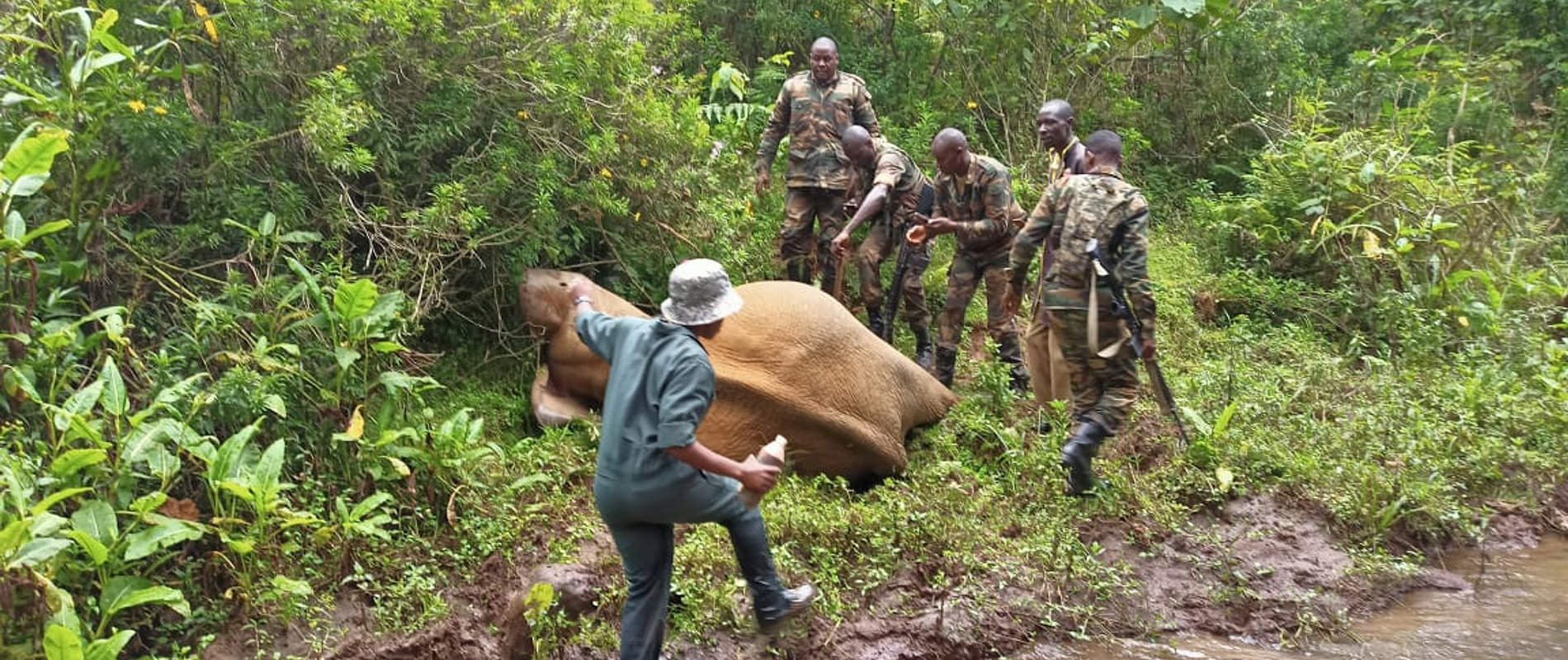When it comes to treating wild animals, nothing ever goes exactly according to plan. Our teams must be committed , tenacious, and undaunted by the challenges that so often present themselves.
That was precisely the case with this snared elephant in the Mount Kenya Forest Reserve. Their efforts were ultimately successful, but only after four days of wading through knee-deep swamps at high altitude and navigating challenging aerial conditions.
It all began on the 20th January, when KWS rangers spotted a young bull with a thick rope snare wrapped around his right front leg. Our SWT/KWS Mount Kenya Mobile Veterinary Unit embarked on a search-and-rescue mission, forging through the forest. Finally, as evening was setting in, they located him. However, the thick terrain — not to mention the aggressively charging patient — proved to be formidable opponents, and the team was not able to land the anaesthetic dart. The elephant retreated deep into the bush, so they called it a night, hoping for more success the next day.


With the memory of the gruelling conditions fresh in their mind, the team requested the mobilisation of our Sky Vets initiative the following morning. A helicopter flew to the scene, landing on a handkerchief-sized patch of land amidst the swamplands to pick up KWS veterinarian Dr. Njoroge. Given the obstacles of the day before, the plan was to dart the patient from the air.
Of course, even the best laid plans can go awry. They quickly spotted the elephant from the air, but he was shielded by an impossibly thick swathe of vegetation with tall trees inhibiting getting any closer to flush him out. Despite the pilot’s attempts to drive him into a more open area, so he could be darted with the anaesthetic, the patient pushed deeper into the forest. Our ground teams valiantly tried to track him down, but the vegetation and seasonal rivers proved effective barriers. Dismayed but certainly not defeated, they gave up for the day, determined to give it a third try the following morning, painfully aware of how much suffering this snare was inflicting.


On the 22nd January, at the first light of day, KWS Mount Kenya Rangers, wildlife scouts, and forest rangers embarked on a foot search for the elephant. Aerial support was again requested, so a fixed-wing airplane from the KWS Mountain Region flew to the scene. While they were able to locate the elephant, he was deep in the forest making treatment impossible. The pilot recorded his GPS coordinates, so boots on the ground could monitor his location and advise the SWT/KWS Mount Kenya Mobile Veterinary Unit when he moved into a more accessible place.
Finally, on the fourth day, there was a breakthrough. The elephant had moved to a water hole in a more open part of the forest, so the team sprung into action. The pain had made the elephant extremely aggressive and he retreated into the thick bushes. Our team wasn’t about to give up, wading across rivers and trudging through swamps to stay on his tail. This was a very precarious situation for all involved; the elephant was on edge and making the situation increasingly dangerous. Thinking on their feet, the team devised a cunning plan to anesthetize him from the safety of a treetop.


The vet and his assisting ranger clambered up a tree that was about 20 meters from the elephant and waited patiently. When finally the opportunity arose, Dr. Njoroge successfully landed the dart. Of course, anaesthetic didn’t work its magic immediately so the team then had to track the patient for about 15 minutes through the bush, until he finally fell recumbent next to a stream.
After a four-day lead-up, the actual treatment took all of half an hour. The team meticulously cut away the snare, taking care to not further exacerbate the brutal injury. The rope had cut about ten centimeters into the skin, causing deep abrasions and a septic wound. The team removed the dead tissue, then cleaned out the wound. As a final step, they applied topical and intramuscular medications and antibiotics to aid healing. The anaesthetic was reversed and, after about four minutes, the bull rose to his feet and continued off into the bush. Monitoring teams will track his recovery over the next two weeks, but his prognosis is good.
This bull is about 15 years old, meaning he is yet to reach the prime of his life. The fact that a simple rope snare could have stolen all of this away from him is a tragedy indeed. Thanks to the perseverance of everyone involved, however, he was gifted a second chance and hopefully has a long life ahead of him.
